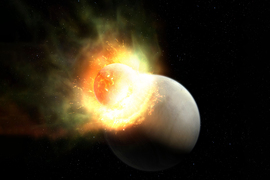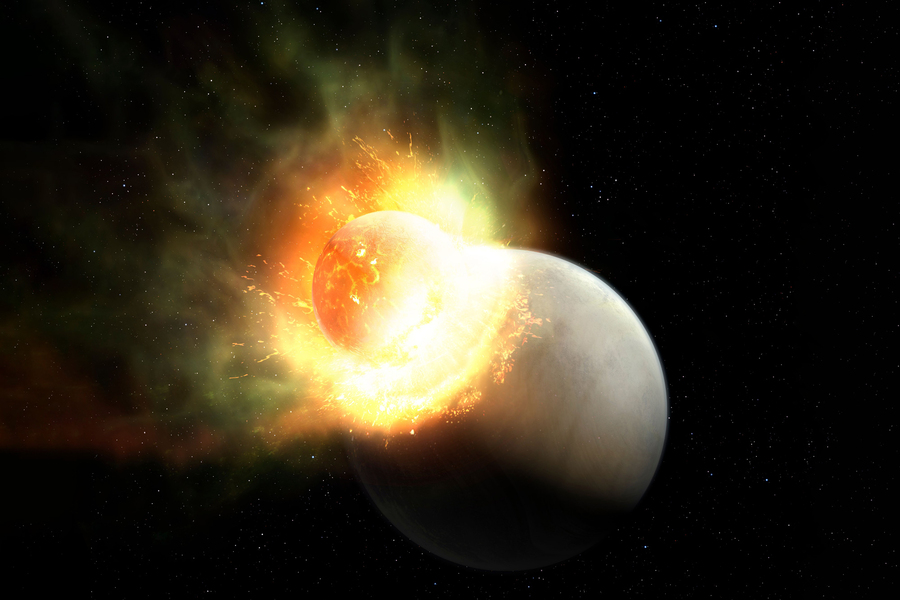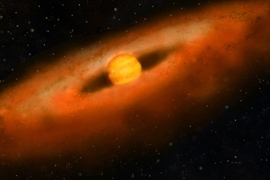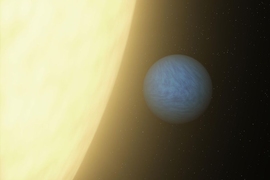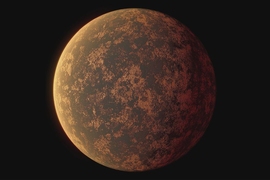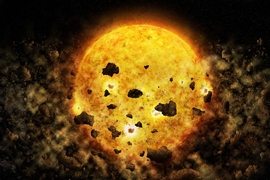Young planetary systems generally experience extreme growing pains, as infant bodies collide and fuse to form progressively larger planets. In our own solar system, the Earth and moon are thought to be products of this type of giant impact. Astronomers surmise that such smashups should be commonplace in early systems, but they have been difficult to observe around other stars.
Now astronomers at MIT, the National University of Ireland Galway, Cambridge University, and elsewhere have discovered evidence of a giant impact that occurred in a nearby star system, just 95 light years from Earth. The star, named HD 172555, is about 23 million years old, and scientists have suspected that its dust bears traces of a recent collision.
The MIT-led team has observed further evidence of a giant impact around the star. They determined that the collision likely occurred between a roughly Earth-sized terrestrial planet and a smaller impactor at least 200,000 years ago, at speeds of 10 kilometers per second, or more than 22,000 miles per hour.
Crucially, they detected gas indicating that such a high-speed impact likely blew away part of the larger planet’s atmosphere — a dramatic event that would explain the observed gas and dust around the star. The findings, appearing today in Nature, represent the first detection of its kind.
“This is the first time we’ve detected this phenomenon, of a stripped protoplanetary atmosphere in a giant impact,” says lead author Tajana Schneiderman, a graduate student in MIT’s Department of Earth, Atmospheric and Planetary Sciences. “Everyone is interested in observing a giant impact because we expect them to be common, but we don’t have evidence in a lot of systems for it. Now we have additional insight into these dynamics.”
A clear signal
The star HD 172555 has been an object of intrigue among astronomers because of the unusual composition of its dust. Observations in recent years have shown that the star’s dust contains large amounts of unusual minerals, in grains that are much finer than astronomers would expect for a typical stellar debris disk.
“Because of these two factors, HD 172555 has been thought to be this weird system,” Schneiderman says.
She and her colleagues wondered what the gas might reveal about the system’s impact history. They looked to data taken by ALMA, the Atacama Large Millimeter Array in Chile, which comprises 66 radio telescopes, the spacing of which can be adjusted to increase or decrease the resolution of their images. The team looked through data from the ALMA public archive, seeking signs of carbon monoxide around nearby stars.
“When people want to study gas in debris disks, carbon monoxide is typically the brightest, and thus the easiest to find,” Schneiderman says. “So, we looked at the carbon monoxide data for HD 172555 again because it was an interesting system.”
In the aftermath
With a careful reanalysis, the team was able to detect carbon monoxide around the star. When they measured its abundance, they found the gas amounted to 20 percent of the carbon monoxide found in Venus’ atmosphere. They also observed that the gas was circling in large amounts, surprisingly close to the star, at about 10 astronomical units, or 10 times the distance between the Earth and the sun.
“The presence of carbon monoxide this close requires some explanation,” Schneiderman says.
That’s because carbon monoxide is typically vulnerable to photodissociation, a process in which a star’s photons break down and destroy the molecule. At close range, there would typically be very little carbon monoxide so close to a star. So, the group tested various scenarios to explain the gas’ abundant, close-in appearance.
They quickly ruled out a scenario in which the gas arose from the debris of a newly formed star, as well as one in which the gas was produced by a close-in belt of icy asteroids. They also considered a scenario in which the gas was emitted by many icy comets streaking in from a far-out asteroid belt, similar to our own Kuiper belt. But the data didn’t quite fit this scenario either. The last scenario the team considered was that the gas was a remnant of a giant impact.
“Of all the scenarios, it’s the only one that can explain all the features of the data,” Schneiderman says. “In systems of this age, we expect there to be giant impacts, and we expect giant impacts to be really quite common. The timescales work out, the age works out, and the morphological and compositional constraints work out. The only plausible process that could produce carbon monoxide in this system in this context is a giant impact.”
The team estimates that the gas was released from a giant impact that occurred at least 200,000 years ago — recent enough that the star would not have had time to completely destroy the gas. Based on the gas’ abundance, the impact was likely massive, involving two proto-planets, likely comparable in size to the Earth. The impact was so great that it likely blew off part of one planet’s atmosphere, in the form of the gas that the team observed today.
“Now there’s a possibility for future work beyond this system,” Schneiderman says. “We are showing that, if you find carbon monoxide in a place and morphology consistent with a giant impact, it provides a new avenue for looking for giant impacts and understanding how debris behaves in the aftermath.”
“What is particularly exciting about this work, in my opinion, is that it demonstrates the importance of atmospheric loss by giant impacts,” says Hilke Schlichting, professor in earth, planetary, and space sciences at the University of California at Los Angeles, who was not involved in the research. “It also opens up the possibility to study the composition of the atmospheres of extra solar planets undergoing giant impacts, which ultimately may help shed light on the atmospheric condition of the terrestrial planets during their own giant impact stage.”
This research was supported, in part, by the ALMA Observatory and the Simons Foundation.
